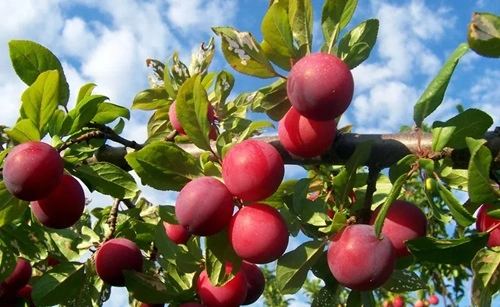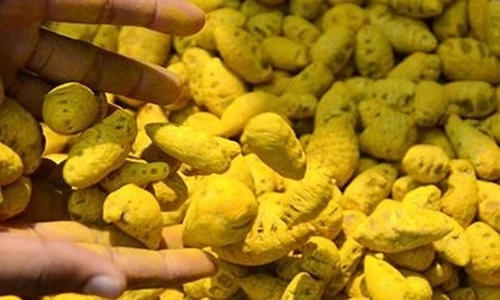Plums are among the most nutritious and delicious temperate fruits cultivated in India. Known for their juicy texture, tangy-sweet flavor, and rich nutritional profile, plums are an excellent source of vitamin C, antioxidants, dietary fiber, and essential minerals. They are consumed fresh, dried (prunes), or processed into jams, juices, and preserves.
Plum cultivation thrives in temperate and subtropical regions with cool winters and warm summers. In India, plum cultivation is concentrated in states like Himachal Pradesh, Jammu & Kashmir, Uttarakhand, Punjab, and parts of Rajasthan and Uttar Pradesh.
This article highlights more than 10 top plum varieties in India, their characteristics, regions of cultivation, and uses, helping farmers and growers select suitable varieties for their needs.

1. Santa Rosa
Santa Rosa is one of the most popular Japanese plum varieties cultivated for its excellent taste and high yield.
- Type: Japanese plum (Prunus salicina)
- Fruit Size: Medium to large
- Color: Reddish-purple skin with amber-yellow flesh
- Harvesting Season: Mid to late summer
- Regions: Himachal Pradesh, Jammu & Kashmir, Uttarakhand
- Characteristics:
- Sweet-tangy flavor with juicy flesh
- Early maturing variety with consistent yield
- Uses: Fresh consumption, jams, and preserves
2. Kala Amritsari
Kala Amritsari is a popular Indian plum variety known for its adaptability to warmer regions.
- Type: Indian plum
- Fruit Size: Small to medium
- Color: Dark reddish-purple skin
- Harvesting Season: Late summer
- Regions: Punjab, Haryana, Rajasthan, Uttar Pradesh
- Characteristics:
- Highly adaptable to subtropical climates
- Tangy flavor with firm texture
- Uses: Fresh consumption, local markets
3. Frontier
Frontier is a high-yielding variety valued for its firm texture and good storage quality.
- Type: Japanese plum
- Fruit Size: Medium
- Color: Reddish-purple skin with yellow flesh
- Harvesting Season: Early to mid-summer
- Regions: Himachal Pradesh, Jammu & Kashmir, Uttarakhand
- Characteristics:
- Firm, juicy flesh with sweet flavor
- High resistance to diseases
- Uses: Fresh consumption, dried plums (prunes)
4. Methley
Methley is an early-maturing plum variety known for its juicy and sweet flavor.
- Type: Japanese plum
- Fruit Size: Small to medium
- Color: Dark red skin with red flesh
- Harvesting Season: Early summer
- Regions: Himachal Pradesh, Uttarakhand
- Characteristics:
- Soft, sweet flesh ideal for fresh consumption
- Tolerant to diverse climatic conditions
- Uses: Fresh eating, juices
5. Black Amber
Black Amber is a high-quality Japanese plum variety cultivated for its firm flesh and excellent flavor.
- Type: Japanese plum
- Fruit Size: Large
- Color: Blackish-purple skin with yellow flesh
- Harvesting Season: Mid-summer
- Regions: Himachal Pradesh, Jammu & Kashmir
- Characteristics:
- Highly firm texture and long shelf life
- Suitable for export markets
- Uses: Fresh consumption, processed products
6. Bhura Amritsari
Bhura Amritsari is an Indian plum variety grown in subtropical regions for its tangy flavor.
- Type: Indian plum
- Fruit Size: Small
- Color: Yellowish-green skin when ripe
- Harvesting Season: Late summer
- Regions: Punjab, Haryana, Uttar Pradesh
- Characteristics:
- Tolerant to heat and drought
- Tangy-sweet flavor preferred in local markets
- Uses: Fresh consumption, pickling
7. Beauty
Beauty is an early-maturing Japanese plum variety known for its sweet and juicy flesh.
- Type: Japanese plum
- Fruit Size: Medium
- Color: Red skin with golden-yellow flesh
- Harvesting Season: Early summer
- Regions: Himachal Pradesh, Uttarakhand
- Characteristics:
- Sweet-tart flavor with high yield potential
- Ideal for fresh markets and home gardens
- Uses: Fresh eating, desserts
8. Stanley
Stanley is a European plum variety grown for its high-quality prunes and fresh consumption.
- Type: European plum (Prunus domestica)
- Fruit Size: Medium
- Color: Dark blue-purple skin with yellow flesh
- Harvesting Season: Late summer
- Regions: Himachal Pradesh, Jammu & Kashmir
- Characteristics:
- Firm flesh with excellent drying properties
- Disease-resistant and high-yielding variety
- Uses: Prunes, fresh consumption
9. Green Gage
Green Gage is a traditional European plum variety known for its sweet flavor and green skin.
- Type: European plum
- Fruit Size: Small to medium
- Color: Green skin with golden-yellow flesh
- Harvesting Season: Mid to late summer
- Regions: Jammu & Kashmir, Himachal Pradesh
- Characteristics:
- Very sweet, honey-like flavor
- Ideal for desserts and preserves
- Uses: Fresh eating, jams, preserves
10. Sharbati
Sharbati is an Indian plum variety with excellent adaptability to semi-arid regions.
- Type: Indian plum
- Fruit Size: Small
- Color: Light red skin with yellow flesh
- Harvesting Season: Late summer
- Regions: Rajasthan, Punjab, Haryana
- Characteristics:
- Tangy flavor preferred in local markets
- Heat-tolerant variety with consistent yield
- Uses: Fresh consumption, pickling
India’s diverse climate allows for the cultivation of multiple plum varieties, from sweet Japanese plums like Santa Rosa and Beauty to traditional Indian types like Kala Amritsari and Bhura Amritsari. By selecting the right variety based on regional conditions and purpose (fresh consumption or drying), farmers can maximize yield and profitability. With increasing demand for fresh and processed plums, plum cultivation offers a promising opportunity for Indian growers.
FAQs
Q1: Which plum variety is best for fresh consumption?
A: Santa Rosa, Beauty, and Methley are excellent for fresh consumption due to their sweet, juicy flavor.
Q2: Which plum variety is ideal for prunes (dried plums)?
A: Stanley and President are the best varieties for drying into prunes.
Q3: Can plums grow in subtropical regions in India?
A: Yes, varieties like Kala Amritsari, Bhura Amritsari, and Sharbati are suitable for subtropical climates.
Q4: What is the difference between Japanese and European plums?
A: Japanese plums (Prunus salicina) are juicier with thin skin, while European plums (Prunus domestica) have firmer flesh and are ideal for drying (prunes).
Q5: Which regions in India are best for plum cultivation?
A: Plums are primarily grown in Himachal Pradesh, Jammu & Kashmir, Uttarakhand, Punjab, and parts of Rajasthan and Uttar Pradesh.

